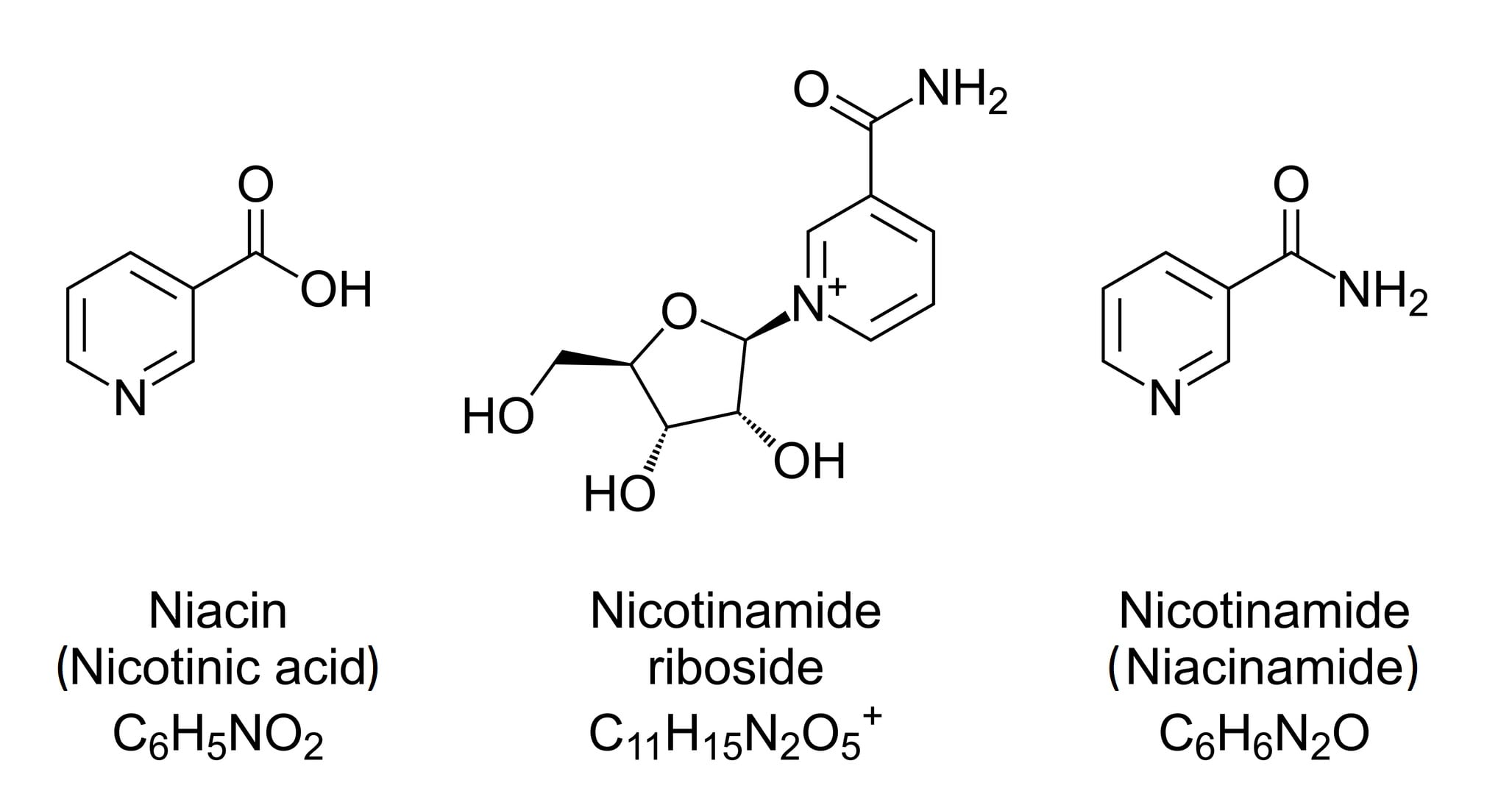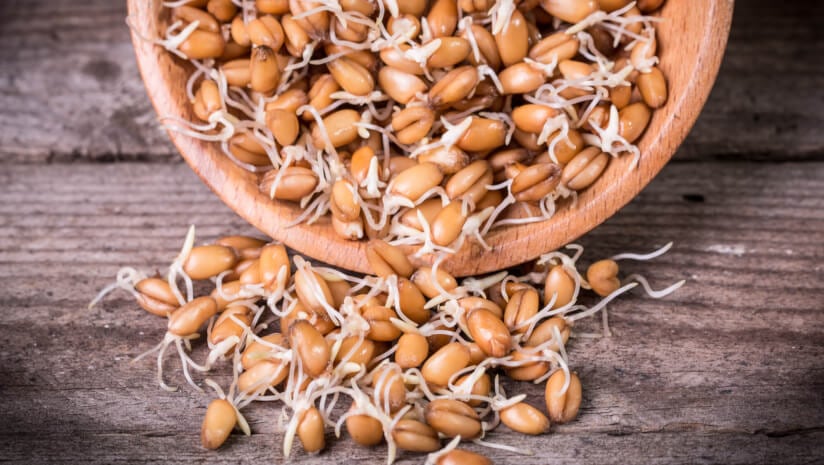There are 12 hallmarks of aging, outlined in a 2023 review by Professor Carlos López-Otín, and dietary ingredients can potentially act on one or more of these processes. From a nutritional perspective, the main processes that have received attention are mitochondrial dysfunction, telomere shortening, chronic inflammation and cellular senescence.
Many ingredients have been linked to improved telomere length, notably omega-3s, carotenoids, selenium and coenzyme Q10 and botanicals like astragalus and scarlet beebalm, to name a few.
These are more ‘everyday’ dietary ingredients, but there are also the specialized ingredients for boosting healthspan like nicotinamide riboside, urolithin A, spermidine and others.
While not intended as an exhaustive list, we offer a glimpse into the key bioactives and their history and scientific context in the healthspan universe.
Resveratrol
One of the first ingredients to gain widespread attention was resveratrol, a molecule found in red wine that was linked to the ‘French Paradox’. The phrase was coined in 1992 by Dr. Serge Renaud from Bordeaux University to describe the low incidence of heart disease and obesity among the French, despite their relatively high-fat diet and levels of wine consumption.
Interest in the polyphenol exploded in 2003 when Dr. David Sinclair and his team at Harvard reported that resveratrol was able to increase the lifespan of yeast cells. The research, published in Nature, was greeted with international media fanfare and ignited flames of hope for an anti-aging pill.
According to Sinclair’s findings, resveratrol could activate a gene called sirtuin1 (Sirt1 – the yeast equivalent was Sir2), which is also activated during calorie restriction in various species, including monkeys.

Working with Christoph Westphal, a scientific entrepreneur, Dr. Sinclair founded Sirtris Pharmaceuticals and developed a drug pipeline for resveratrol. Sirtris was acquired by GlaxoSmithKline for a whopping $720 million in 2008.
The resveratrol story soured a little with GSK shuttering the Sirtris business in 2013 after reports of adverse effects related to the resveratrol formulation under investigation. (While some of the other Sirtris Sirt1-activator candidates are still in play, they are reportedly not resveratrol analogues.)
Resveratrol itself remains a compound of interest in the dietary supplements space for a range of potential health benefits, and a recent dose-response meta-analysis of randomized controlled trials (RCTs) offered some hope.
“This extensive analysis did not find a significant impact of resveratrol supplementation on Sirt1 levels based on the overall meta-analysis,” wrote scientists from the University of Camerino in Italy in the Journal of the Academy of Nutrition and Dietetics. “However, subgroup and sensitivity analyses suggested signs of a potential stimulatory effect of resveratrol on Sirt1. Notably, this effect seems to depend on the dosage and duration of resveratrol intake. Therefore, further research involving larger and more diverse participant populations is warranted to refine the understanding of resveratrol’s influence on human Sirt1 levels.”
Nicotinamide Riboside (NR)
In 2004, Dr. Charles Brenner discovered that nicotinamide riboside (NR)—a version of niacin (vitamin B3)—is a potent precursor to nicotinamide adenine dinucleotide (NAD). NAD is an important cellular co-factor for improvement of mitochondrial performance and energy metabolism.
As organisms age, NAD+ levels drop, which leads to a decrease in mitochondrial health; this in turn leads to age-related health issues. NAD+ levels also can be depleted by lifestyle choices such as overeating and lack of exercise. By boosting NAD+, NR can increase mitochondrial health and induce the creation of new mitochondria.
Irvine, CA-based Niagen Bioscience (formerly Chromadex) began accumulating the IP surrounding NR by licensing patents from Cornell University, Dartmouth College and Washington University in St. Louis. This IP has been challenged over the years, but Niagen remains the leading player in this sector.
Other companies are also playing in the NR space, notably Elysium and Thorne. During a recent presentation at the International Conference on the Science of Botanicals (ICSB), Dr. Andrew Shao, senior vice president of global regulatory & scientific affairs at Niagen Bioscience, noted that year-on-year growth of NR supplements is exploding, with sales of its Tru Niagen product increasing 33% from Q1 2023 to Q1 2024. Sales of NR supplements that are formulated with Niagen (the branded ingredient that is available to third-party brands) have increased 1,330%. Sales of other NR supplements (not affiliated with Niagen Bioscience) have seen their sales increase by 470%, he said.
The potential health benefits of NR are reported in dozens of clinical trials, with the data consistently showing that oral NR supplementation can increase NAD+ levels, including in the brain, improve endothelial function in blood vessels and reduce inflammatory biomarkers.

Nicotinamide Mononucleotide (NMN)
Linked to NR is NMN, another vitamin B3 form that has also been reported to increase NAD+ levels in the cells of the body. NMN is prominent in many markets around the world, but the situation in the United States is complicated.
The U.S. Food and Drug Administration announced in November 2022 that NMN is not allowed as a dietary ingredient because of its prior investigation as a drug. This was despite issuing an acknowledgement without objection for a New Dietary Ingredient Notification (NDIN) in May 2022. The agency walked back its NDI determination after having been made aware of the drug studies on the ingredient, it stated at the time.
This stance is currently being challenged by the Natural Products Association (NPA), which filed suit against FDA last year, but then NPA and the U.S. Department of Justice (DOJ) came together in October 2024 to seek a temporary break in the battle over NMN. U.S. District Judge Paul Friedman granted the stay of legal proceedings to allow FDA to evaluate the NMN citizen petition, which was filed by NPA and the Alliance for Natural Health (ANH) in March 2023. The Court requires the FDA to respond by the end of July 2025.
Until then, the situation for NMN will remain clouded.
NMNH
When the FDA made its 2022 determination that NMN was not a legal dietary ingredient, some retailers (notably Amazon) removed NMN supplements from their platforms and shelves. Stepping into this gap came NMNH (dihydronicotinamide mononucleotide).
FDA has not made any public decisions on NMNH as a dietary ingredient. When asked to comment on NMNH by NutraIngredients in October 2024, a spokesperson for the agency cited the NMN Citizen Petition, and stated: “Our decision on these pending citizen petitions will directly affect our position regarding the use of NMN as or in a dietary supplement. It may also impact articles that may be related to NMN. Accordingly, at this time, the FDA has no further comment on NMN, or articles that may be related to NMN such as NMNH.”
While that may suggest that the agency views NMNH as similar to NMN, the science tells a different story.
According to studies published in 2019 and 2021, NMNH leads to NAD+ production through a pathway that is distinct from NR and NMN.
Niagen Bioscience’s Dr. Shao told us: “While NR and NMN use the NRK pathway to produce NAD+, NRH and NMNH go around this pathway and produce NAD+ via NADH. Preclinical research indicates that NRH and NMNH are more potent NAD+ boosters.”
“However, all published studies to date have involved administration via injection or infusion; the stability and bioavailability of orally administered NMNH has not been investigated,” he added. “Further, there are as yet no published human studies.”
ChromaDex/Niagen Bioscience announced in August 2024 that it had been granted a U.S. Patent covering the composition of matter for the disodium salt of NMNH.
“NMNH is a new dietary ingredient (NDI) which has not been properly notified to FDA, rendering its legal status as a dietary supplement questionable at present,” Chromadex shared in a press release issued about the patent.
One company, Shanghai-based Effepharm Ltd., stated last year that it had self-affirmed the GRAS (Generall Recognized As Safe) status of its UthPeak-branded NMNH.
Urolithin A
Urolithin A is a compound generated by gut microflora from ellagitannins found in food such as pomegranate. The compounds are hydrolyzed in the stomach into ellagic acid, which is subsequently converted by the gut microflora into urolithin A. However, not everyone has the right microflora to be able to make the metabolite.
Life sciences company Timeline has developed a method to deliver finely calibrated doses of urolithin A. Preliminary data published in Nature Medicine indicated that urolithin A may improve mitochondrial function by stimulating mitophagy, a process by which damaged mitochondria are recycled to permit a renewal with healthy mitochondria. These potent beneficial effects have been demonstrated in several different organisms, including in human clinical trials.
Most of the data to date has focused on the ingredient’s benefits for muscle health, with clinical trials in a range of population and age groups. Recently, results of a randomized clinical trial with 88 healthy people published in Cell Reports Medicine (2022) showed that Urolithin A supplementation boosted exercise endurance and physical performance.
Timeline offers a range of consumer products and has also commercialized its proprietary urolithin A as Mitopure. The company has also signed strategic partnerships with Nestlé and L’Oréal.
The newest addition to the Timeline portfolio is a sugar-free strawberry gummy, with two gummies provide the recommended 500 mg dose of Urolithin A Mitopure.

Trigonelline
In addition to Urolithin A and the NAD+ precursors, Nestlé is interested in trigonelline, a compound found in fenugreek seeds and coffee beans, that may boost NAD+ levels, enhance muscle strength and prevent fatigue during aging.
As reported by NutraIngredients, levels of trigonelline, a naturally occurring alkaloid and structurally related to nicotinic acid (vitamin B3), were found to be lower in older people with sarcopenia. Levels of the compound also correlate positively with muscle strength.
In studies with Caenorhabditis elegans, mice and humans, trigonelline supplementation was found to boost NAD+ levels, with additional insights from the C. elegans experiments showing that it may reduce age-related muscle wasting and increase lifespan.
“Our findings expand the current understanding of NAD+ metabolism with the discovery of trigonelline as a novel NAD+ precursor and increase the potential of establishing interventions with NAD+ -producing vitamins for both healthy longevity and age-associated diseases applications,” said Assistant Professor Vincenzo Sorrentino from the National University of Singapore (NUS Medicine), one of the research institutions involved in the study, in an NUS press release following publication of the study in the journal Nature Metabolism.
Spermidine
Spermidine is a polyamine compound that was originally identified in semen (hence the name) but is present in a variety of dietary sources, including wheat germ, soybeans, cheddar cheese, mushrooms and mango.
Austria-based The Longevity Labs GmbH launched spermidineLIFE in the EU 2019 and was recognized as “The Most Innovative OTC-Product” at the German 2020 Pharma Trend Image & Innovation Awards in Munich. The company launched into the United States in 2020 via its U.S. subsidiary Longevity Labs Inc.
As reported previously by NutraIngredients, the compound is receiving increasing attention for its significant promise in limiting the effects of aging. Several other studies have reported the potential cognitive health benefits in humans, including a paper in 2018 in Cortex, which concluded that spermidine supplementation for three months was associated with “a positive impact on memory performance in older adults with subject cognitive decline.”
A 2022 paper in the Journal of Anatomy reported that data from mice suggested that spermidine supplements may protect the mitochondria in the hearts of older individuals due to the compound’s ability to stimulate both the removal (mitophagy) and creation of new mitochondria (biogenesis).
Commenting on the science in 2021, Dr. Mark Miller, principal at Kaiviti Consulting, told NutraIngredients that several studies have focused on stimulating autophagy (Schroeder et al 2021, Schwarz et al 2018).
“Spermidine helps clear out damaged and dysfunctional organelles, like mitochondria, which drag cells down with their inefficiencies and resultant oxidative stress,” Dr. Miller. “These benefits of spermidine appear to be critical and central because they are ancient or highly conserved.”
He noted that they are also evident across species—flies, worms, mice and humans.
“Spermidine and related polyamines appear to hold significant promise in limiting the effects of aging and appear to be effective when administered as a dietary supplement,” Dr. Miller added.

2-HOBA
Found naturally in buckwheat seeds, particularly in Himalayan Tartary buckwheat, 2-Hydroxybenzylamine (2-HOBA) was investigated as a standalone ingredient by Dr. Naji Abumrad, MD, a surgeon at Vanderbilt University.
The ingredient’s development was until recently housed within a company called Metabolic Technologies, which is a spinoff of Iowa State University. Metabolic Technologies was acquired by TSI in 2020, which has commercialized the ingredient under the brand name Hobamine.

The science of 2-HOBA is linked to the formation of reactive oxygen species (ROS), which are formed during basic cellular metabolism. While moderate ROS levels play a critical role in cellular signaling, excessive ROS formation can then lead to lipid oxidation-derived compounds, such as isolevuglandins (IsoLGs). These IsoLGs are very reactive, and they are reported to form adducts with lysine residues, which can lead to detrimental changes in protein function, immunogenicity and epigenetic alterations that may contribute to inflammatory diseases.
Rather than trying to attack the process of ROS formation, 2-HOBA targets these IsoLGs. When present in the bloodstream, 2-HOBA reportedly binds to IsoLGs with a thousand times greater affinity than IsoLGs have for their typical targets.
A 2023 study published in Inflammation with 17 healthy younger participants (average age of 34) and 16 healthy older participants (average age of 66) indicated that 2-HOBA supplementation produced significant changes in 15 immune proteins, including significant increases in levels of CCL19, IL-12B, IL-10 and TNF-beta.
The ingredient is already used in commercial products, including BigBoldHealth’s HTB Rejuvenate, SRW’s Cel and Healthgevity’s Telomere Prime.
Alpha-Ketoglutarate
Many different AKG supplements are already available in the market, with some making claims relating to healthy aging, cellular energy and “reducing age-related inflammation.”
An extensive review published in 2022 in Trends in Endocrinology & Metabolism outlined the compound’s “very important role in cellular energy, metabolism, antioxidative stress, immune response and epigenetic regulation,” but noted that the mechanisms of action are not full understood.
It is known that AKG is an intermediate in the Krebs cycle, a key process in mitochondria that is involved in the production of cellular energy. According to the review by scientists from the National University of Singapore, “Many studies have indicated that AKG can prevent muscle breakdown and improve bone mineral density. Dietary supplementation of AKG has a positive effect on reducing chronic inflammation.”
“Recently, it has been hypothesized that AKG can regulate the aging process and have an effect on prolonging healthspan,” they wrote. “Exciting results from preclinical studies indicate that mTOR is involved in human chronic diseases, where modulation of mTOR activity by AKG may play important role in aging.”
There are some big questions still to be answered about AKG, however, notably the optimal daily dose for longevity, the form of AKG that will produce the optimal effects and whether AKG impacts gut integrity and the gut microbiome.
Ergothioneine
A sulfur-containing amino acid, Ergothioneine functions as an antioxidant. Mushrooms are a primary source of ergothioneine in nature.
The science of L-ergothioneine has been developing over the last 20 years. A 2005 paper by Gründemann et al. published in PNAS reported the existence of a specific transporter for ergothioneine, where cells accumulate the amino acid and “avidly retain it.”
“In the human body, the ability to absorb, distribute and retain [ergothioneine] depends entirely on this specific transporter,” wrote Gründemann in a later review (Preventive Medicine, 2012). “Its existence implies a beneficial role for [ergothioneine] and its blockade or inactivation in animal models may be essential to at last understand the function of [ergothioneine].”
A 2010 paper by Solomon Snyder, MD, professor of neuroscience at Johns Hopkins University School of Medicine, describes the amino acid as a possible vitamin: “Evidence that [ergothioneine] is a physiologic antioxidant raises the question of its ‘status’ in biology. Despite its high concentration and ubiquitous presence, all mammalian ET derives from dietary sources. The existence of [an ergothioneine transporter] establishes [ergothioneine] as an important normal body constituent. In this sense, [ergothioneine] probably fits the definition of a vitamin.
“Classic criteria require that depletion of a putative vitamin elicit pathological consequences. No pathological syndrome of [ergothioneine] deficiency has been reported. However, lack of such reports may simply reflect the relative dearth of [ergothioneine] research as well as the difficulty of depleting [ergothioneine].”
Commercialization of the ingredient was hampered for many years by the cost, but recent advances in precision fermentation have led to the launch of cost-effective ergothioneine by companies like Blue California and NNB Nutrition.

Others
Other “geroprotective” ingredients that could have made the list include taurine, PQQ, quercetin, fisetin, to name a few. There is also the emerging role of the microbiome in aging, which was the focus of a session at Probiota in Copenhagen in February 2025.
The science is deepening all the time, and the number of ingredients is also sure to grow. What is clear is that longevity supplements are here for the long haul.





